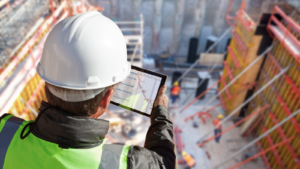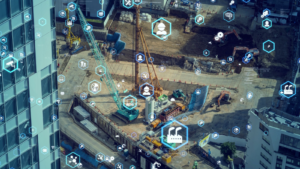As global challenges continue to evolve, the need for adaptive and resilient construction methods has never been more critical. Industry leaders are focusing on integrating cutting-edge technologies like AI, robotics, and IoT to enhance efficiency and reduce costs. These construction industry trends 2024 not only promise to revolutionize the way structures are built but also ensure they are more environmentally friendly and sustainable.
Construction Industry Trends 2024
Artificial Intelligence and Robotics
 AI and robotics improve precision and efficiency. AI algorithms analyze data to predict project outcomes, optimize scheduling, and enhance safety. Robots handle repetitive tasks, reducing human error and speeding up construction processes. For example, autonomous machinery completes tasks faster with fewer labor costs, enhancing productivity.
AI and robotics improve precision and efficiency. AI algorithms analyze data to predict project outcomes, optimize scheduling, and enhance safety. Robots handle repetitive tasks, reducing human error and speeding up construction processes. For example, autonomous machinery completes tasks faster with fewer labor costs, enhancing productivity.
BIM offers detailed digital representations of physical and functional aspects of buildings. BIM aids in project planning, design, construction, and management. With synchronous updates and real-time collaboration, stakeholders detect issues early, ensuring smoother project execution and cost savings. This technology enhances project visualization, resulting in fewer errors and better resource allocation.
3D Printing and Prefabrication
3D printing and prefabrication streamline construction processes. 3D printers create complex components quickly, reducing material waste. Prefabrication assembles parts off-site, accelerating the building timeline. For instance, prefabricated modules improve quality control and minimize delays caused by on-site variables. These methods support sustainable construction by decreasing energy consumption and waste.
Sustainability and Green Building Practices
Sustainability remains central to the latest construction industry trends 2024.
Energy-Efficient Materials
 Energy-efficient materials, like insulated concrete forms and low-emissivity windows, significantly reduce energy consumption. These materials improve thermal insulation, reducing heating and cooling costs. For instance, phase-change materials help in maintaining optimal indoor temperatures by absorbing and releasing heat. Advanced roofing materials also enhance energy efficiency, leading to lower overall environmental impacts.
Energy-efficient materials, like insulated concrete forms and low-emissivity windows, significantly reduce energy consumption. These materials improve thermal insulation, reducing heating and cooling costs. For instance, phase-change materials help in maintaining optimal indoor temperatures by absorbing and releasing heat. Advanced roofing materials also enhance energy efficiency, leading to lower overall environmental impacts.
Reducing the carbon footprint is crucial in modern construction. Strategies like carbon capture and the use of carbon-neutral materials, such as bamboo and recycled steel, are becoming prevalent. Implementing on-site renewable energy sources, for example, solar panels and wind turbines, further decreases emissions. Additionally, green building certifications, such as LEED and BREEAM, guide and encourage sustainable construction practices.
Sustainable Infrastructure
Sustainable infrastructure prioritizes longevity and resource efficiency. Practices include integrating water-saving technologies, like rainwater harvesting systems and low-flow fixtures, into building designs. Promoting the use of renewable and recycled materials ensures long-term resource availability. Urban green spaces, such as green roofs and vertical gardens, enhance air quality, mitigate the urban heat island effect, and promote biodiversity within urban environments.
Workforce and Labor Market Changes
Labor Shortages
The construction industry faces notable labor shortages, driven by an aging workforce and a lack of new entrants. According to the Associated General Contractors (AGC), 81% of construction firms report difficulty finding qualified workers. This shortage impacts project timelines and costs, emphasizing the need for strategies to attract younger talent. Solutions include vocational training programs and partnerships with educational institutions.
Worker Safety and Training
 Worker safety and training remain critical in an industry prone to high injury rates. Emphasizing safety protocols and regular training reduces workplace incidents and fosters a safer environment. OSHA reports that training programs in fall protection, respiratory safety, and equipment handling result in a 20% decrease in on-site injuries. Integrating VR and AR technologies in training enhances practical learning experiences, further improving safety outcomes.
Worker safety and training remain critical in an industry prone to high injury rates. Emphasizing safety protocols and regular training reduces workplace incidents and fosters a safer environment. OSHA reports that training programs in fall protection, respiratory safety, and equipment handling result in a 20% decrease in on-site injuries. Integrating VR and AR technologies in training enhances practical learning experiences, further improving safety outcomes.
Diversity and inclusion efforts are increasingly vital in the construction sector, promoting varied perspectives and innovation. According to McKinsey, firms with diverse workforces are 35% more likely to outperform their peers. Implementing diversity initiatives and inclusive hiring practices, such as outreach programs for underrepresented groups, ensures a more balanced and effective workforce. These strategies also enhance company reputation and employee satisfaction.
Adaptive and Resilient Construction Methods
The construction industry is on the cusp of a significant transformation as it heads into 2024. With the integration of advanced technologies and a steadfast commitment to sustainability, the sector is poised for enhanced efficiency and greener practices. The construction industry trends 2024 promises to be more efficient, sustainable, and inclusive, setting a new standard for the years to come.

